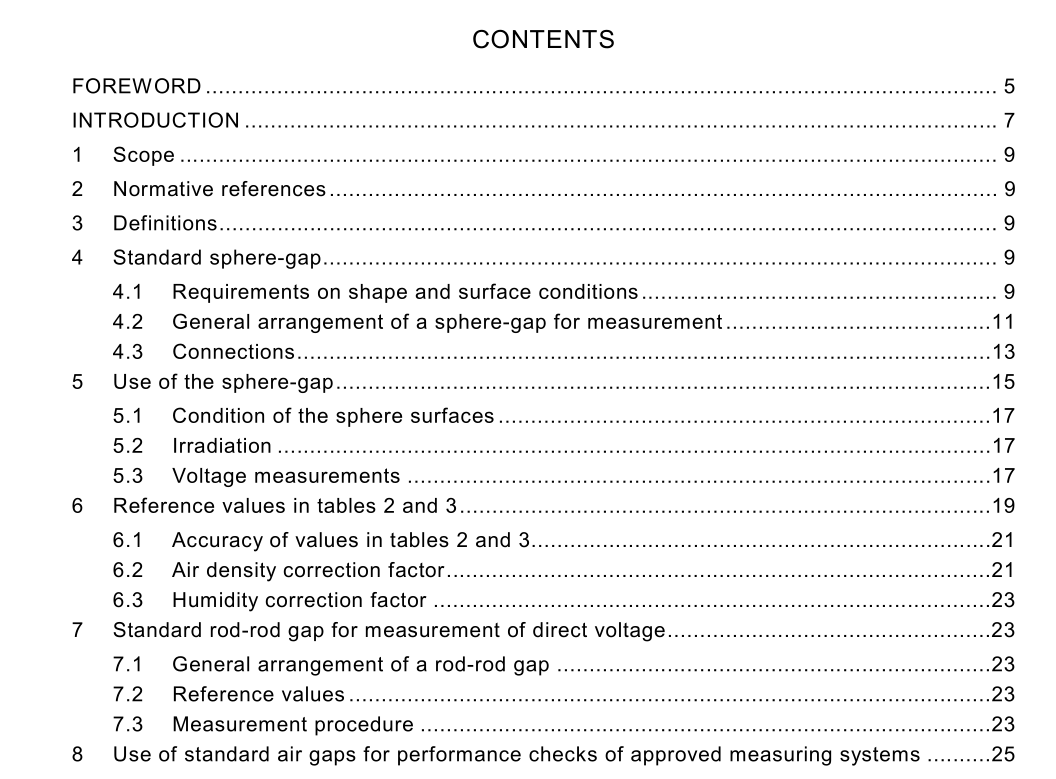IEC 60052 pdf download

IEC 60052 pdf download.Voltage measurement by means of standard air gaps
1 Scope
IEC 60052 sets forth recommendations concerning the construction and use of standard air gaps for the measurement of peak values of the following four types of voltage: a) alternating voltages of power frequencies; b) full lightning impulse voltages; c) switching impulse voltages; d) direct voltages. Air gaps constructed and used in accordance with this standard represent IEC standard measuring devices in accordance with IEC 60060-2 and are primarily intended for performance checks of high voltage measuring systems.
2 Normative references
The following referenced documents are indispensable for the application of this document. For dated references, only the edition cited applies. For undated references, the latest edition of the referenced document (including any amendments) applies. IEC 60060-1 :1 989, High-voltage test techniques – Part 1: General definitions and test requirements IEC 60060-2:1 994, High-voltage test techniques – Part 2: Measuring systems
3 Definitions
vacant
4 Standard sphere-gap
The standard sphere-gap is a peak voltage measuring device constructed and arranged in accordance with this standard. The points on the two spheres which are closest to each other are called the sparking points. Figures 1 and 2 show two arrangements, one of which is typical of sphere-gaps with a vertical axis and the other of sphere-gaps with a horizontal axis. 4.1 Requirements on shape and surface conditions The standard sphere-gap consists of two metal spheres of the same diameter D, their shanks, operating gear, insulating supports, supporting frame and leads for connection to the point at which the voltage is to be measured. Standard values of D are 2 – 5 – 6,25 – 1 0 – 1 2,5 – 1 5 – 25 – 50 – 75 – 1 00 –1 50 and 200 cm. The spacing between the spheres is designated S.
The spheres shall be carefully made so that their surfaces are smooth and their curvature is as uniform as possible. The tolerances on size and shape need usually only be checked when the spheres are first supplied and any suitable instrument (e.g. spherometer) may be used. The diameter of each sphere shall not differ by more than 2 % from the nominal value. The spheres shall be reasonably free from surface irregularities in the region of the sparking point. A medium grade mechanical surface finishing (roughness R max below 1 0 µm) is considered to be adequate. The region of the sparking point is defined by a circle such as would be drawn on the spheres by a pair of dividers set to an opening of 0,3 D and centred in the sparking point. When the sphere-gap is used, it will normally be sufficient to examine the surface by touch and visual inspection. NOTE Any minor damage on the non-adjacent hemispherical surfaces does not alter the sphere-gap performance. 4.2 General arrangement of a sphere-gap for measurement 4.2.1 Vertical gap When the spheres are arranged vertically, the shank of the high-voltage sphere shall be free from sharp edges or corners and the diameter of the shank shall not exceed 0,2 D over a length D. This requirement is made in order to reduce the influence of the high-voltage shank on the disruptive discharge voltage. If a stress distributor (corona shield) is used at the end of the shank, its greatest dimension, perpendicular to the axis of the spheres, shall not exceed 0,5 D and shall be at least 2 D from the sparking point of the high-voltage sphere. The earthed shank and the operating gear have a smaller effect and their dimensions are therefore less important. Figure 1 gives the limits of size of the components of a typical vertical sphere-gap. The sphere shanks should be visually in line.4.2.2 Horizontal gap When the spheres are arranged horizontally, the limiting dimensions of a typical sphere-gap are given in figure 2. They are the same for both sides of the gap. The sphere shanks should be visually in line. 4.2.3 Height of the spheres above the horizontal earth plane The height A of the sparking point of the high-voltage sphere above the earth plane of the laboratory floor shall be within the limits given in table 1 . If the sphere-gap is mounted with the earthed sphere nearest to the ceiling, and if other surfaces such as walls and the floor are at a considerably greater distance, then the ceiling shall be regarded as the horizontal plane, from which the distance A is measured downwards.









